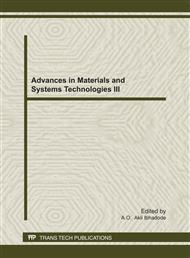[1]
S.S. Tonapi, R.A. Fillion, F.J. Schattenmann, H.S. Cole, J.D. Evans, G.G. Sammakia. An overview of thermal management for next generation microelectronic devices. SEMI Advanced Manufacturing Conference. IEEE (2003), pp.250-254.
DOI: 10.1109/asmc.2003.1194502
Google Scholar
[2]
Ernesto Gutierrez Gonzalez, Jesus Alvarez Florez, Sebastien Arab. Development of the Management Strategies of the ECU for an Internal Combustion Engine Computer Simulation. Mechanical Systems and Signal Processing 22 (2008), pp.1356-1373.
DOI: 10.1016/j.ymssp.2007.11.030
Google Scholar
[3]
Purcell, John Jerl Sowerby, Paul Hodzen, Edward P. Andrews, Eric B. US 6, 655, 326 United States, Dec. 2, (2003).
Google Scholar
[4]
Katsuhito Yoshida, Hideaki Morigami. Thermal properties of diamond/copper composite material. Microelectronics Reliability 44 (2004), p.303–308.
DOI: 10.1016/s0026-2714(03)00215-4
Google Scholar
[5]
J. -M. Molina, M. Rheme, J. Carron and L. Weber. Thermal conductivity of aluminum matrix composites reinforced with mixtures of diamond and SiC particles. Scripta Materialia 58 (2008), p.393–396.
DOI: 10.1016/j.scriptamat.2007.10.020
Google Scholar
[6]
Th. Schubert, B. Trindade , T. Weißgarber , B. Kieback. Interfacial design of Cu-based composites prepared by powder metallurgy for heat sink applications. Materials Science and Engineering A 475 (2008), p.39–44.
DOI: 10.1016/j.msea.2006.12.146
Google Scholar
[7]
Th. Schubert, A. Brendel, K. Schmid, Th. Koeck, L. Ciupinski, W. Zielinski, T. Weißgarber, B. Kieback. Interfacial design of Cu/SiC composites prepared by powder metallurgy for heat sink applications. Composites: Part A 38 (2007), p.2398–2403.
DOI: 10.1016/j.compositesa.2007.08.012
Google Scholar
[8]
Mark A. Occhionero, Robert A. Hay, Richard W. Adams, Kevin P. Fennessy. Cost-effective manufacturing of aluminium silicon carbide (AlSiC) electronic packages. International Symposium on Advanced Packaging Materials. (1999), pp.118-124.
DOI: 10.1109/isapm.1999.757298
Google Scholar
[9]
R. Treichler, T. Weissgaerber, T. Kiendl. TOFSIMS analysis of Cu–SiC composites for thermal management applications. Applied Surface Science 252 (2006), p.7086–7088.
DOI: 10.1016/j.apsusc.2006.02.117
Google Scholar
[10]
R. Prieto, J.M. Molina, J. Narciso, and E. Louis. Fabrication and properties of graphite flakes/metal composites for thermal management applications. Scripta Materialia 59 (2008), pp.11-14.
DOI: 10.1016/j.scriptamat.2008.02.026
Google Scholar
[11]
Ravi Bollina and Sven Knippscheer. ElectronicsCooling. Advanced Metal Diamond Composites – Love and Heat Relationship. [Online] 1 November 2008. [Cited: 7 April 2010. ] http: /www. electronics-cooling. com/2008/11/advanced-metal-diamond-composites-love-and-heat-relationship.
Google Scholar
[12]
Zweben, Carl. Electronics Cooling. Revolutionary, New Thermal Management Materials. [Online] 1 May 2005. [Cited: 25 March 2010. ] http: /www. electronics-cooling. com/2005/05/quot-revolutionary-quot-new-thermal-management-materials.
Google Scholar
[13]
Patrick K. Schelling, Li Shi, and Kenneth E. Goodson. Managing heat for electronics. materialstoday 8 (2005), pp.30-35.
Google Scholar
[14]
Julian Norley, Jim J. -W. Tzeng, George Getz, Jeremy Klug, Brian Fedor. The development of a natural graphite heat-spreader. Seventeenth SEMI-THERM Symposium. IEEE (2001), pp.107-110.
DOI: 10.1109/stherm.2001.915157
Google Scholar
[15]
Zhanjun Liu, Quangui Guo, Jingli Shi, Gengtai Zhai, Lang Liu. Graphite blocks with high thermal conductivity derived from natural graphite flake. CARBON 46 (2008), p.414 – 421.
DOI: 10.1016/j.carbon.2007.11.050
Google Scholar
[16]
Dr. James A. Cornie, Shiyu Zhang, Robert Desberg, Mark Ryals. Discontinuous graphite reinforced aluminum, and copper alloys for high thermal conductivity-thermal expansion matched thermal management applications. [Online] 18 November 2003. [Cited: 18 March 2010. ] www. mmccinc. com.
Google Scholar
[17]
K.C. Leong, L.W. Jin, H. Y. Li, J.C. Chai. Forced convection air cooling in porous graphite foam for thermal management applications. s. l. : IEEE, (2008), pp.57-64.
DOI: 10.1109/itherm.2008.4544254
Google Scholar
[18]
Steve B. White, Nidia C. Gallego, Daniel D. Johnson, Kevin Pipe, Albert J. Shih, Edward Jih. Graphite foam for cooling of automotive power electronics. IEEE (2004), pp.61-65.
DOI: 10.1109/pet.2004.1393797
Google Scholar
[19]
James Klett, Lynn Klett, Tim Burchell, Claudia Walls. Graphitic foam thermal management materials for electronic packaging. Oak Ridge National Laboratory : Society of Automotive Engineers, Inc., (2000).
DOI: 10.4271/2000-01-1576
Google Scholar
[20]
Kevorkijan, V. Belgrade, Yugoslavia. Development of Al MMC composites for automotive industry. s. n. The Syposiam on Deformation and Structure of Metals and Alloys. (2002).
Google Scholar
[21]
E. Delannay, C. Colin, Y. Marchal, L. Tao, F. Boland, P. Cobzaru, B. Lips, M.A. Dellis. Processing and properties of metal matrix composites reinforced with continuous fibres for the control of thermal expansion, creep resistance and fracture toughness. s. l. : Journal de Physique IV (1993).
DOI: 10.1051/jp4:19937263
Google Scholar
[22]
J.W. Kaczmar, K. Pietrzak, W. WøosinÂski. The production and application of metal matrix composite materials. Journal of Materials Processing Technology 106, (2000), pp.58-67.
DOI: 10.1016/s0924-0136(00)00639-7
Google Scholar
[23]
Aluminium Metal matrix Composites Technology Roadmap. Technologies Research Corporation, USA. [Online] 2002. [Cited: 5 January 2010. ] www. almmc. com/AlMMCRoadmapMay2002. pdf.
Google Scholar
[24]
Zhensong Tong, Zhoushen Shen, Yujuan Zhang. Aluminium/Diamond composites and their applications in electronic packaging. IEEE. (2007), pp.1-7.
Google Scholar


